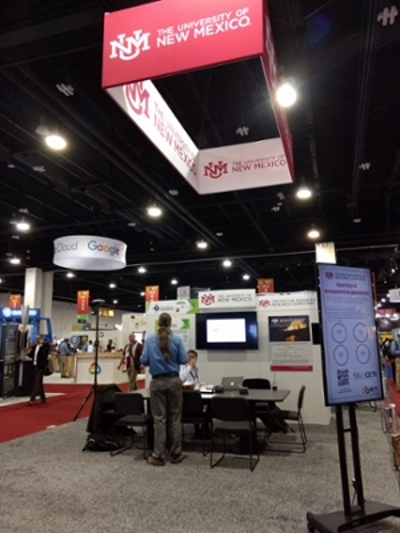CARC team attending premier supercomputing event
 A team from The University of New Mexico’s Center for Advanced Research Computing traveled to Dallas November 12-16 to participate in SC18: The International Conference for High Performance Computing, Networking, Storage, and Analysis. The CARC contingent and thousands of other people from all over the world met at the event to network with peers, colleagues, and industry leaders. CARC hosted a booth at the event that highlighted UNM’s research and researchers.
A team from The University of New Mexico’s Center for Advanced Research Computing traveled to Dallas November 12-16 to participate in SC18: The International Conference for High Performance Computing, Networking, Storage, and Analysis. The CARC contingent and thousands of other people from all over the world met at the event to network with peers, colleagues, and industry leaders. CARC hosted a booth at the event that highlighted UNM’s research and researchers.
“It’s the premier technical and trade show in the industry so it’s a great place to meet with colleagues to discuss current challenges and new approaches in large scale and high-performance computing,” said CARC director Patrick Bridges. “We also met with vendors to understand what products are available to help our researchers more effectively conduct cutting edge research. And it’s a way to publicize the great research UNM and our partners are doing.”
The CARC team included Bridges, CARC unit administrator Tracy Wenzl, research assistant professor Matthew Fricke, network and storage specialist Hussein Al-Azzawi, systems analyst Jose Sanchez, and research assistants Keira Haskins and William “Pepper” Marts.
The CARC booth featured digital posters that highlighted research done using CARC resources. Projects ranged from an examination of the genetics of viruses to Martian robot swarms to a consortium effort that will revolutionize New Mexico’s electrical grid to incorporate solar and wind power. Find out more about the research projects here.
Al-Azzawi headed early to SC18. He’s a member of the SCinet team, a group that assembled the event’s powerful high-capacity network infrastructure.
“The job was to build the fastest network on earth in a week. Network speed is about 4Tbps,” Al-Azzawi explained.
“Most event networks are for a few hundred people with cellphones,” Bridges said. “This one was for 12,000 people with laptops and major vendors with supercomputers. It supported companies like Cray and Intel and all the supercomputing centers. They had to put it up, support it through the week, take it down, and do it again next year. It’s very technologically challenging.”
As the director of CARC, Bridges met with peers in the Coalition of Academic Supercomputing Centers to discuss strategic planning of supercomputing in the United States. Most of the CARC group also attended seminars, tutorials, and panel discussions and present their own research projects.
“So, there’s a good professional development aspect of SC18 for our staff and research assistants,” Bridges said.
For more information about SC18, go to the event website. CARC posted about SC18 on Facebook and Twitter.
